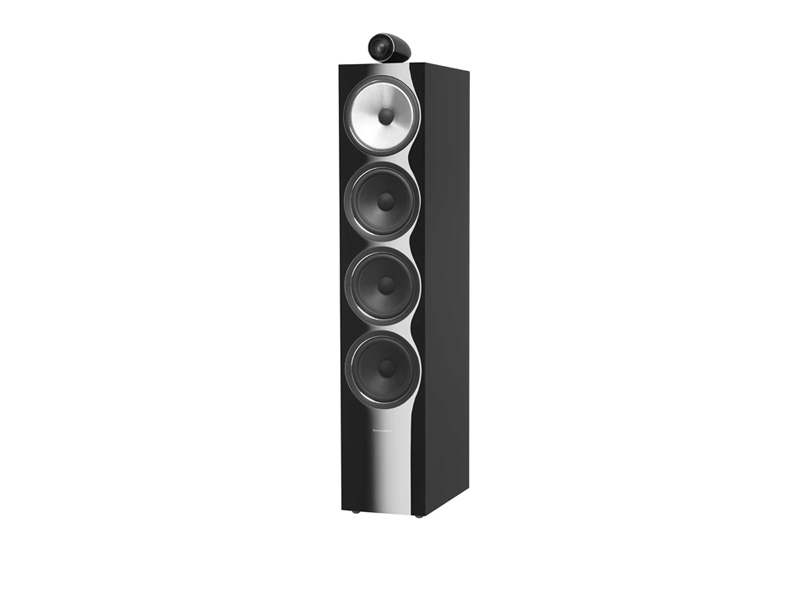B&W launches all-new 700 Series speaker range
This extensive new range incorporates technologies from the way-more-expensive 800 Series.

Bowers and Wilkins has announced details of its new speaker range, the 700 Series. The nine-strong range (three standmounters, three floorstanders, a couple of centre speakers and a subwoofer) supercedes the CM Series.
Exclusive first review: B&W 707 S2 review
The 700 Series incoporates both brand-new technologies and trickle-down tech from the well-received 800 Series. The new tweeter design is dubbed Carbon Dome, and is designed to deliver cleaner, sweeter high frequencies than the outgoing CM Series' Aluminium Double Dome tweeter. The company claims it's the best-performing 'non-Diamond' tweeter it's ever produced.
The tweeter comprises two sections: the front portion, a 30-micron aluminium dome, is stiffened by a carbon coating, while the second section is a 300-micron Carbon Ring. This is then bonded to the inner surface of the structure. B&W is attributing exceptional rigidity and a first break-up point of 47kHz to this design.

Technologies adopted from the 800 Series include the use of B&W's proprietary 'Continuum' material midrange driver, which the company is (again) suggesting is its cleanest and most transparent midrange cone design yet. The Continuum cone's design is based on controlled flexibility and the avoidance of too abrupt a transition from pistonic to break-up modes of behaviour.
Those models that include bass drivers use a tweaked version of the Aerofoil profile driver first seen on the 800 Series. It uses a paper, rather than a carbon fibre, skin and has differently specified material as the filling in the 'sandwich'.
As is B&W's wont, the smallest and most affordable speaker in the range - the 707 S2 - has the biggest model number. It's also the model you can read an exclusive review of here.
The latest hi-fi, home cinema and tech news, reviews, buying advice and deals, direct to your inbox.
The range breaks down like so: the 707 S2, a two-way vented design with 25mm tweeter and 13cm mid/bass driver, costs £800 per pair. The 706 S2, which ups the mid/bass driver to a 16.5cm design, is £1100. And the biggest standmounter, the 705 S2 (pictured above) is a tweeter-on-top design with the same driver array as the 706 S2 - it comes in at £1800 per pair.
The tweeter-on-top models feature Solid Body Tweeter technology derived from the 800 Series. The tweeter is sited in a solid aluminium housing weighing over a kilo - which almost by definition is exceptionally inert.

The floorstanders start with the 704 S2, a three-way vented box design with 25mm Carbon Dome tweeter, 13cm midrange driver and a pair of 13cm bass drivers. They're £2000 per pair.
Then comes the 703 S2, which ups the driver dimensions to 15cm for the midrange and 16.5cm for each of its bass drivers. A pair will set you back £2400.
The range tops out with the 702 S2 (pictured above), another tweeter-on-top design with the same driver proportions as the 703 S2. They'll set you back £3300 per pair.
In addition, there's a £600 centre speaker (HTM72 S2) that's a two-way vented design with 25mm tweeter and a pair of 13cm mid/bass drivers. If that seems a little tentative, the HTM71 S2 is a three-way design with 25mm tweeter, 10cm midrange driver and a couple of 16.5cm bass drivers.
Bass is also available from the DB4S subwoofer. This £1350 design has a single 10in carbon aerofoil cone, driven by 1000 watts of amplification.
The range (or, at least, the standmounting element of the range) is finished off by the dedicated FS-700 S2 speaker stands. Available in black or silver, they're £400 per pair.
Each speaker, including the sub, is available in either gloss black, satin white or rosenut finishes - and they're all available now.
MORE:
Best speaker deals - wireless, hi-fi, Bluetooth
Wilson Audio WAMM Master Chronosonic speakers - yours for £700k
10 of the best songs to test your speakers
Listen to the What Hi-Fi? playlist
Simon Lucas is a freelance technology journalist and consultant, with particular emphasis on the audio/video aspects of home entertainment. Before embracing the carefree life of the freelancer, he was editor of What Hi-Fi? – since then, he's written for titles such as GQ, Metro, The Guardian and Stuff, among many others.
